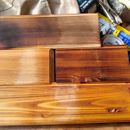Tongue-and-groove siding joints
Hey folks,
I’m hoping to install some 6in cedar tongue-and-groove siding horizontally over vertical Rainvent battens next week. As my boards are all 10 ft long I will need three to four pieces to span the long edge of the house and will therefore have oodles of joints. It seems the standard here is a 45 degree bevel join (scarf joint?). I will treat all cuts with the same semi-transparent stain I’ve used to pre stain all the boards. Questions:
1. Should these joints between adjacent pieces of siding be caulked or glued? I’ve seen people on this forum recommend metal flashing behind the joints instead, but I’m not sure how that would work with tongue-and-groove boards.
2. For the anti-caulk contingent: what of siding to trim and trim to window joints?
3. Caulk or not, should butt joints like those between siding and trim be afforded an expansion gap?
4. Does anyone have reasons for or against running trim over siding verse butting siding to trim assuming critical areas like window heads are afforded a metal flashing?
I’ve attached a photo of the siding-siding joint mocked up with some of my stained test pieces. It all fits together pretty snug.
Thanks!
-Tanner
GBA Detail Library
A collection of one thousand construction details organized by climate and house part










Replies
Tanner,
With the rain screen behind there, it doesn't matter much what you do with the joints. Mostly comes down to what you prefer visually, with a large surface like a wall, the joints disappear (most important part is to make them random). The scarf joints are the least visible.
Trim if at the same plain as the siding should be caulked all the way around except for the head flashing where you need the drainage gap.
If you are doing the trim above the siding, it is best to bring the flashing and sill out past the trim so that no water can collect and sit on the horizontal sections.
P.S. if you want to get the benefit of charred wood, you need to burn them way more. For the darker tone, less work to just use a darker stain.
Hopefully your siding has a rabbited joint along the bottom edge. A rabbited joint really helps prevent wildfire from getting under the siding whereas a flat bevel siding won't.
I've read on this site that you shouldn't caulk between the siding and the trim, you should leave a small gap so that whatever water gets behind the siding can get out (also increases ventilation). Make sure, of course, that the sheathing is protected behind the joint.
1. Should these joints between adjacent pieces of siding be caulked or glued? I’ve seen people on this forum recommend metal flashing behind the joints instead, but I’m not sure how that would work with tongue-and-groove boards.
>No Caulk or glue, both will fail within a few years and actually slow down drying time. I also would not use metal flashing behind joints either, completely unnecessary IMO
2. For the anti-caulk contingent: what of siding to trim and trim to window joints?
> I would use 5/4 material and simply butt the siding up to the trim, but some of this is going to depend on how your windows are set relative to the rain screen
3. Caulk or not, should butt joints like those between siding and trim be afforded an expansion gap?
> I would install it tight, even if kiln dried, the siding will shrink during hot sunny streaks, and then expand and tighten up during the rain.
4. Does anyone have reasons for or against running trim over siding verse butting siding to trim assuming critical areas like window heads are afforded a metal flashing?
> Depends on how the windows are installed. if trim is protruding I will rip or angle it at least 15 degrees to shed water.
I think the best analogy for why you don't need caulk and why a lot of modern building products are oversold is if you just look at a cheaply built barn with no insulation. Aside from splash back, the boards take forever to rot, even sinfully detailed trim doesn't rot. If it can dry faster than it gets wet, it's gonna last a long time.
A rain screen turns your house into a really expensive barn.
If it really bothers you, and you've got time to kill, make a T & G cut on the ends of the boards. What are you going to do at the end of the board where it meets the vertical trim?.....Don't sweat the small things in life.
Thanks folks! Nathan: I think "a rainscreen turns your house into a really expensive Barn" may be my new favorite quote from this site, especially because my house is exactly that at this stage of construction